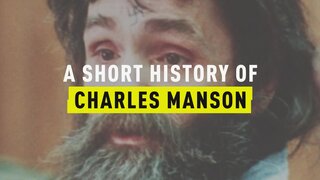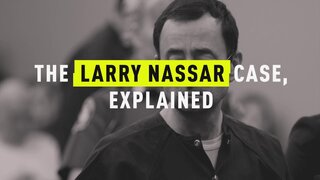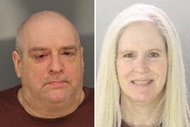Create a free profile to get unlimited access to exclusive videos, breaking news, sweepstakes, and more!
What Was ‘Preppy Killer’ Robert Chambers' Connection To The Catholic Church And Disgraced Ex-Cardinal Theodore McCarrick?
After Chamber’s arrest for killing 18-year-old Jennifer Levin in 1986, prominent members of the Catholic clergy rallied around the former altar boy.
Robert Chambers may have been facing a murder charge for allegedly strangling his 18-year-old friend to death, but he had unexpected and powerful allies in his corner: prominent members of the Catholic church.
After the 19-year-old Chambers' arrest, members of the Catholic community rallied around the handsome prep student: a high-ranking bishop wrote a letter in support of his bail; a parish leader offered him a place to stay while he awaited trial; and some clergy even attended his trial.
“All of this was supposed to cloak Rob in the holiness of the Catholic church. He was a good boy from a religious family. Look he is living with the priests,” former prosecutor Linda Fairstein said of the defense’s strategy in the docu-series “The Preppy Murder: Death In Central Park.” “They are not afraid of him, nobody has to be.”
Chambers’ case also had a connection to a powerful and now disgraced figure in the Catholic church—Theodore McCarrick—who would later be accused of sexually abusing young boys.
McCarrick, who was the archbishop of Newark at the time of Jennifer Levin's 1986 death, took the unusual step of writing the judge a letter advocating for Chambers’ release on bond.
He wrote the letter in support of Chambers’ character and said he had known Chambers, a former altar boy, for years through his mother Phyllis Chambers, a devout Catholic, The New York Times reported at the time.
Chambers was accused of strangling Levin to death in Central Park in the early morning hours of Aug. 26, 1986. When investigators went to question him about his relationship with Levin, they discovered he had deep scratch marks on his face and chest. He later admitted to killing the 18-year-old but claimed that it had been an accident after Levin tried to force him into rough sex.
“I couldn’t take it anymore and I managed to get my left hand free, so I kind of sat up a little and just grabbed at her. I just grabbed her neck as hard as I could and she just flipped over me and landed right next to the tree, and then she didn’t move,” Chambers said in his police confession tape aired in the series.
But prosecutors didn’t buy his story and charged him with murder.
The Need For A Powerful Ally
Roger Stavis, an attorney on Chambers’ defense team, said in the docu-series –– which premiered last week on Sundance and AMC –– that the defense had wanted to secure bond for their client; however, they were concerned that Chambers’ alleged connection to a string of robberies and his past drug use could paint him in an unfavorable light.
“We had information about the burglaries and about Robert’s addiction. These were huge problems for him and they became huge problems for us. How can we ensure that we could get bail? The judge, Howard Bell, was under tremendous pressure to not grant bail in the case so we wanted to bring out positive facts that helped to support our defense and one thing that was extremely helpful was when the Archbishop of Newark Theodore McCarrick submitted a bail letter for Robert Chambers,” he said.
Fairstein said what the letter did was “throw all the weight of the Catholic church behind Robert” and Bell eventually granted Chambers a $150,000 bond.
“People were deathly afraid of McCarrick. He had tremendous clout,” Michael Sheehan, lead investigator in the case, said in the series.
But that wasn’t the end of the Catholic church’s involvement. After the bond was set, Chambers and his family were unable to pay it, so members of the church reportedly began to help raise money to get him out of jail.
“There was one monsignor who put up his entire life savings for bail for Robert Chambers,” Stavis recalled. “He said, ‘I am just following Jesus Christ, I am helping a person in need.’”
Monsignor Thomas P. Leonard also offered to supervise Chambers while he awaited trial and said Chambers could even live at his church. Leonard had known Chambers as a student at St. David’s, an elementary school in Manhattan, the Times reported.
“When the New York Archdiocese is saying Robert Chambers can go to one of our churches and we’ll look out for him, that carries a lot of weight,” television reporter Magee Hickey said in the five-part series.
But while the church’s support was a triumph for the defense team, led by Jack Litman—who used the strategy of blaming the victim in the case—it was less well received by the victim’s family.
“This was all part of Jack Litman’s orchestration,” Levin’s mother, Ellen Levin, said in the series. “To the public, it looked like he was a young, clean, good Catholic boy.”
Clergy Support During Chambers’ Trial
Catholic clergy members even attended Chambers’ murder trial, sitting on the defense’s side in the courtroom.
“It bothered me during the trial that there was this sense that the Catholic church is there to help Robert Chambers,” Hickey said. “It was a dangerous place for the Catholic church to be. Why are they taking sides here?”
While Chambers earned the support of some powerful members of the church, Archbishop of New York Cardinal John O’Connor worried at the time that the church’s support of Chambers could create tension between Catholics and Jews.
''I am worried that the Catholic 'Establishment' will be seen as rallying around its 'own,' seeming to protect and defend its own, while a Jewish girl lies dead and her family is shattered with grief,” he wrote in the weekly publication Catholic New York at the time, according to The Times.
O’Connor also wrote that his “personal sympathies are with both families” and that he did not want to be part of “any injustice” toward either family involved in the highly publicized case.
As the jury began to deliberate in the case, Chambers ultimately decided to strike a deal with the prosecution that allowed him to plead guilty to manslaughter in exchange for a sentence of five to 15 years behind bars. He’d serve all 15 years due to infractions committed behind bars and was released in 2003. However, his freedom would be short-lived and as he was later arrested for selling drugs out of his girlfriend’s apartment. He was sentenced in 2008 to 19 years behind bars for the drug and assault charges against him. He remains in prison today.
McCarrick’s Own Fall From Grace
McCarrick would also have his own fall from grace after allegations surfaced that he had sexually abused young boys. McCarrick, a former D.C. archbishop and cardinal, was defrocked earlier this year as a result of the accusations, according to The Washington Post.
McCarrick was initially accused of sexually abusing two minors and sexually harassing seminarians, but more allegations surfaced after the first accusations became public. He has now been accused of abusing at least seven boys from 1970 to 1990, three sources told the Post last month.
By the time the allegations surfaced, McCarrick had already retired from his post as the archbishop of Washington D.C. but he had remained a prolific fundraiser, Slate reports. After the allegations were revealed, McCarrick resigned as a cardinal, the first clergy member of that high standing to do so as the result of sexual abuse allegations. He was defrocked –– stripped of his status as a priest –– by the Vatican in February.
“I’m not as bad as they paint me,” he told Slate earlier this year. “I do not believe that I did the things that they accused me of.”






























